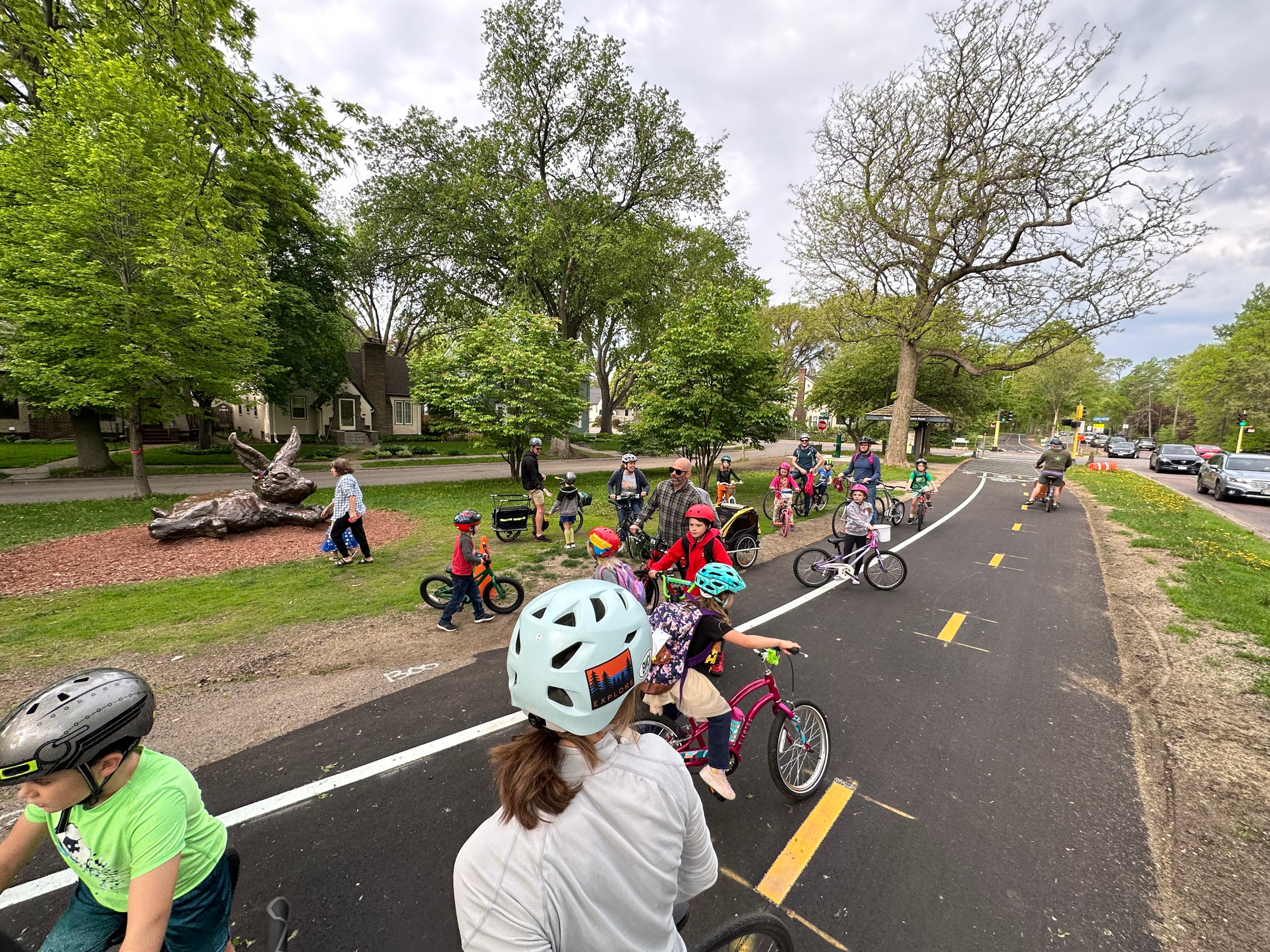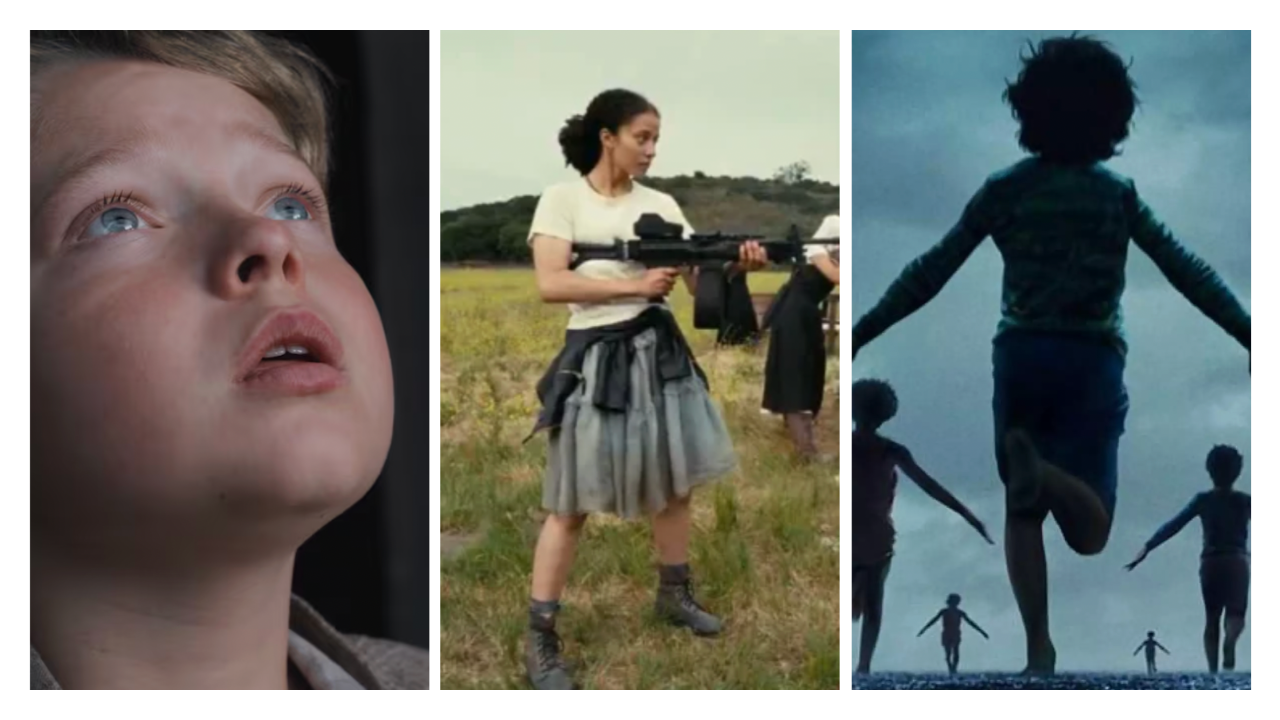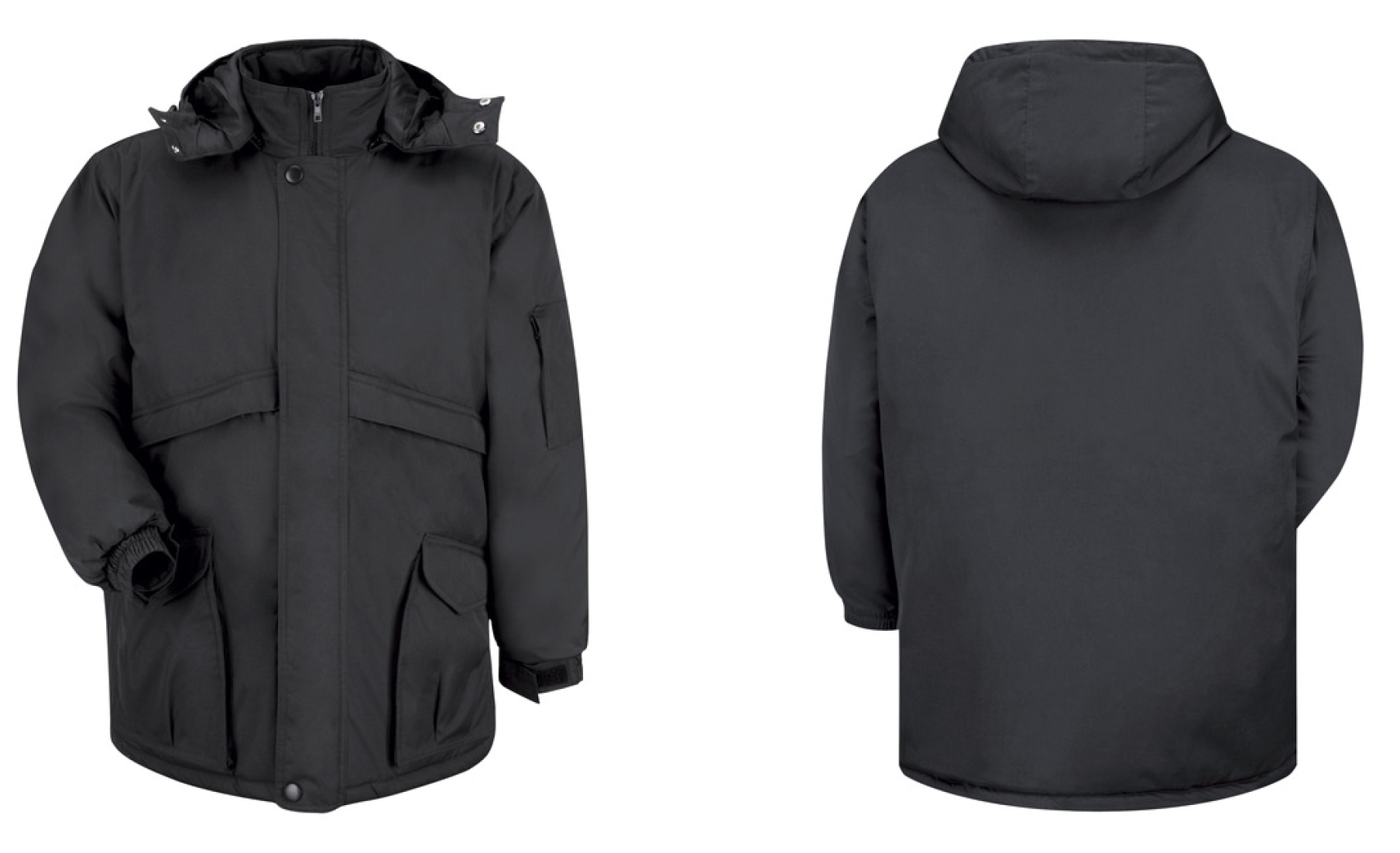It’s one of those top-tier Twin Cities days—65 degrees, blue skies, a slight breeze rustling through the trees—and Julius, age 8, and Etta, age 6, are bursting with excitement.
It’s a perfect day for a bike ride. Or a bike bus ride.
“It definitely gets ‘em up. Thursdays are an easier get-out-of-bed, get-ready-to-go day,” says their mom, Kate Vickery, who like the rest of the family sports a colorful "bike bus" shirt designed by local author and illustrator Drew Brockington.
“They’ll start chanting, ‘Bike bus! Bike bus!’” adds dad Kyle Shelton, as he maneuvers his Yuba e-bike in their south Minneapolis driveway.
Over the next half-hour, as a mix of ABBA and Barenaked Ladies and Bob Marley pumps from a speaker bungeed to Shelton’s bike, the family will collect dozens of young cyclists and their parents on a route that begins at the foot of their driveway on East 53rd Street, winds up and down a few side streets in their Hale neighborhood, and eventually heads for Minnehaha Parkway. They’ll meet with another group of riders at the Minnehaha Bunny, more than doubling their ranks, before heading up 12th Avenue towards Hale Elementary School, where the kids lock up their bikes and head inside to begin the school day.
Bike buses like this one, which started last fall, exploded in popularity throughout 2022. The idea is simple: It’s like a regular old school bus, except everyone is on bikes. The “bus driver”—in this case, Shelton—leads the slow-rolling pack along an established route, and young riders wait at intersections or at the bottom of their own driveways to join the passing caravan.
The full Hale route runs about two miles, roughly 30 minutes from door to door, on Thursdays when the weather permits. Some weeks there are just six or seven families on the group ride; on lovely days like today, roughly two-dozen students put on their helmets and backpacks and pedal to school. Drivers honk and wave, and folks walking their dogs smile, charmed by the rambunctious group of riders.
It’s easy to understand their reactions—the bike bus is one heck of an adorable spectacle. Could it also be the future of school transportation?
For Shelton and Vickery, biking to school has been a part of life since their kids were young. They’re lucky to live close to Hale, and Shelton is also the director of the University of Minnesota’s Center for Transportation Studies.
“From my perspective, it’s a great way to sort of start the day with activity, and end up doing something fun,” he explains. “As a person working in transportation and really caring about how people are safely and effectively moving through our world, it’s about that experience, too.”
Theirs isn’t the only bike bus in Minneapolis—before the first group ride to Hale, Shelton connected with local dads Mike Torres and Devin Olson, who have been coordinating a twice-annual ride to the Lake Nokomis Community School for about six years now. “It’s always been the intent that we just show people the way,” Torres says. “Our answer is always, ‘Just go ahead and do it.’” Lake Nokomis’s biannual rides regularly welcome about 100 students; Torres says providing donuts from Mel-O-Glaze doesn’t hurt.
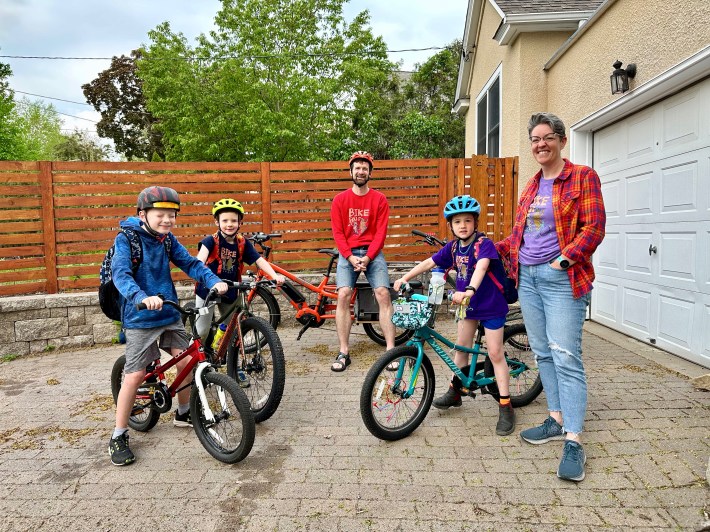
With rides every Thursday morning during the fall and spring, Hale’s bike bus, while smaller, is among the most consistent. Shelton was inspired by a phys ed teacher named Sam Balto, whose weekly Friday rides to Alameda Elementary School in Portland, Oregon, have quickly become the face of the bike bus movement.
“It’s pretty wild, I think I’ve seen three articles in the past week that cite the Alameda bike bus as the inspiration to do it,” Balto chuckles. Though he in turn cites Barcelona’s “bicibús” and San Francisco’s SF Bike Bus among the inspiration for organizing his elementary school’s first bike bus on Earth Day in 2022, his bike bus has been profiled everywhere from Bicycling magazine to Momentum Mag to the Washington Post within the last few months.
Prior to founding the Alameda bike bus, as an educator in Boston, Balto led regular walking school buses to Ellis Elementary School, but he says the Earth Day bike bus ride in Portland was supposed to be a one-day event. When 75 kids showed up on their bikes, “I kind of didn’t have a choice but to keep it going,” he admits. More parents volunteered to help, and the Alameda bike bus’s numbers swelled from 75 students to more than 120 in about six weeks.
One reason the Alameda bike bus is so often cited as the inspiration by parents around the country is that Balto smartly harnessed the power of social media. The PE teacher uploads photos and 360 videos of the weekly rides to Twitter and TikTok, where nearly 77,000 people follow along. Seeing videos of children laughing and cheering as they ride to school together is a powerful thing. It looks like a lot of fun. And it is!
@coachbalto Replying to @Artie Burns don’t blame the #BikeBus for being late to work. #saferoutestoschool #activetransportation #teachertiktok #schoolpickupline #walkingschoolbus #parentpickupline #schoolstreets #physicaleducation
♬ original sound - Coach Balto
But bike buses, while utterly delightful and a guaranteed serotonin boost, are more than just a pleasant way to start the day. Balto says there’s a positive mental-health impact for participating students, adding that the rides help “scaffold independence,” and show young people that they have the ability to get around on their own.
Shelton agrees: Bike buses expose kids to the autonomy, freedom, and yes, fun of getting around on two wheels. He’s seen it with some of the kids and even their parents—a moment of realization that they can bike for transportation, not just for something to do on weekends.
Balto notes that active transportation like biking or walking to school helps reduce congestion around the school and contributes to a safer, cleaner environment for students. He conducted a survey of Alameda families at the end of last summer, which found that over one-third of participating students are typically driven. “When you think of that from a climate action standpoint, that’s making an impact,” he says.
“And we know that students who walk or bike to school have fewer truancy issues than students that don’t,” adds Dave Cowan, Safe Routes to School coordinator with the Minnesota Department of Transportation. On a related note, Cowan points to MnDOT teacher surveys that have found that on Bus Stop and Walk Days, on which students are dropped off about a half mile from school, kids are far more likely to sit in their seats, stay in their seats, and pay attention in class: “They’ve had a chance to get their wiggles out before they arrive in the classroom.”
Julie Danzl, student wellness manager with Minneapolis Public Schools, adds that the district has been actively incorporating bike education and encouraging students to ride bikes to, from, and even while at school—for example, there was a lot of interest in walking and biking field trips, so the district developed a walking and biking field trip guide for teachers. “Busing can be a barrier for field trips, often, either because of cost or, frankly, bus driver shortages in general have kind of impacted the availability of busing for field trips,” she says. Walking and biking field trips can help alleviate that pressure.
“I describe walking school buses and bike buses as like a Swiss army knife for school issues,” Balto says. “Like, literally tell me what your school is trying to address, and the walking school bus or the bike bus is probably one of your best tools to address it.”
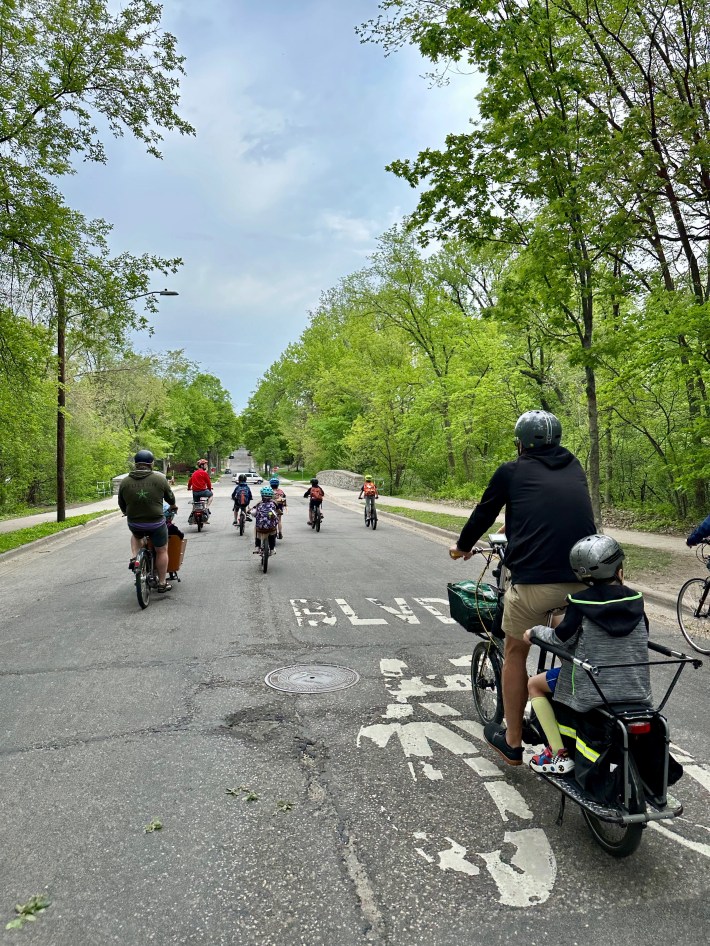
Torres says the rides have been beneficial for participating parents, too, many of whom hang out after the bike bus drops their kids off to chat and reconnect with one-another—a less common experience now that so many work remotely or on a hybrid schedule.
“You get the sense that all the parents are loving it just as much as the kids,” he says, “like it’s our opportunity to see our neighbors.”
“It’s something I feel like people can really get behind. Seeing children thrive is a narrative that hasn’t been present in a while, and people are really craving community and social connection,” Balto says. “And we can’t do that with everybody driving individually in cars. Bikes are a great tool to use to create joy and freedom for our children and our communities.”
In 1969, 48% of children ages 5 to 14 usually walked or bicycled to school, according to the National Center for Safe Routes to School. By 2009, that number had dwindled to just 13%.
“The short way of saying that is, kids aren’t walking and biking to school like they used to,” says Safe Routes to School coordinator Cowan. “And there’s a lot of reasons for that, and a lot of impacts on kids and families because of it.”
Parents cite traffic-related dangers among the top barriers preventing their kids from walking or cycling to school, and they’re not wrong to. The U.S. is among the most dangerous places in the world for bicyclists and pedestrians, and pedestrians and cyclists of color are more likely to be struck and killed by motor vehicles than those who are white. Both pedestrian and cyclist deaths are on the rise.
In this way, the bike bus is something of an indictment of our current transportation infrastructure. Students shouldn’t have to take over the streets in packs to be able to cycle to and from school without being struck by a car.
“Bike buses are a weekly demonstration and a call to action to our city leaders to create space for children to be able to move safely,” Balto says. He jokes that it gets people bike-pilled. “You come for the joy, kids riding bikes, you get fed a little activism around making streets safer for kids.”
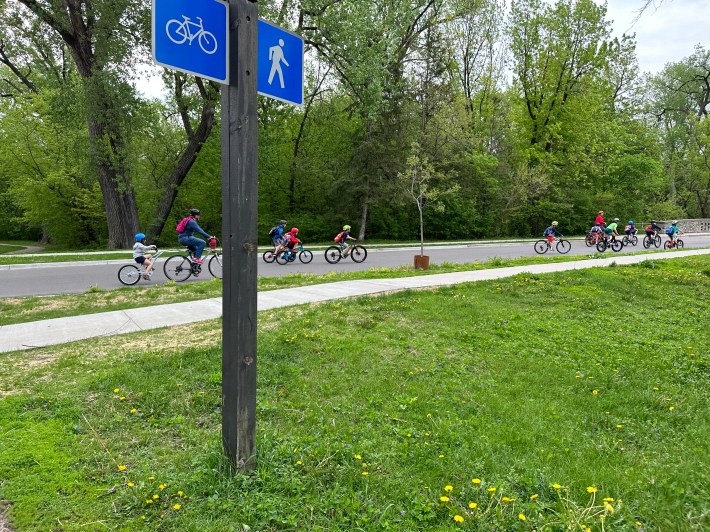
To his point, at various times during the Hale ride, parents discussed the area’s infrastructure—one wondered aloud whether it would be realistic to convert some of the streets nearest to the school into one-ways, making it easier for big yellow school buses and bike buses alike to navigate them.
But bike buses, and the people who organize them, face their own challenges. For one, they tend to be volunteer-led, which means they’re more common in neighborhoods where parents can afford to lend their time and effort.
“I’m the first to admit that like, our family has the resources and the time for me to not clock into the office until 9,” Shelton says. It’s inherently inequitable. “Not every school, or every community, has the wherewithal to do this type of thing.”
There’s also an access issue: Not every student owns or knows how to ride a bicycle. Student wellness manager Danzl says the latest Safe Routes to School Strategic Plan includes universal bike education for all fourth and fifth graders in Minneapolis Public Schools—at one school, 35% of fourth graders didn’t know how to ride a bike.
“Minneapolis is a biking city,” she says. “Our city invests millions of dollars in bicycle infrastructure, and this program really helps students to experience that beauty, understand what a bike lane is, and understand that it belongs to them, too.”
And Shelton notes that like all volunteer-run initiatives, the bike bus runs the risk of disappearing when its leaders move on. “Our family will eventually be away from Hale. Will somebody else want to do it? I don’t know!”
Bike bus leaders say they’d like to see cities and school districts think about incentivizing and supporting the initiative financially. Could the school district hire someone to lead the bike bus? Could they pay the parent volunteers?
“We know how to teach children how to ride bikes. We know how to give children bikes. We know how to lead bike buses, on a regular basis, and pay people to do it, like a legitimate job,” Balto says. “We know how to do all those things individually, we just need to put it together. You can do a bike bus anywhere. All it takes is money and political will.”
The gears are starting to shift. In Portland, a so-called “bike bus bill” would expand distinct transportation funding to be available to bike buses, walking school buses, crossing guards, and public transit passes.
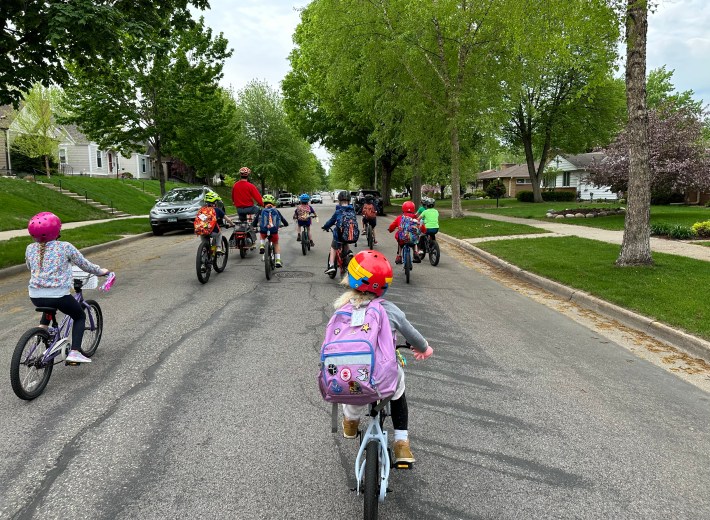
In Minnesota, MnDOT’s Cowan notes that organizers are able to apply for Boost Grants, which launched a few years ago “when we decided to stop telling people what we wanted to fund and asked them what they needed to fund to make it safer and easier and more convenient for kids to walk and bike to school in their communities.” Those grants have already funded walking school bus leaders, and he says bike buses would almost certainly qualify.
Cowan also encourages parents to advocate for support and funding. “When you have a group of people that are regularly participating in a bike bus, you’ve kind of built a little bit of a contingent that can speak to those issues—to principles, or the school district administration, or city staff—to help them understand that this is a need that should be met,” he says.
Mike Torres feels that momentum building. Early in his kids’ careers at Lake Nokomis Community Schools, in 2013 or so, he remembers getting a pamphlet from Wenonah Elementary discouraging students from biking to school because it was too dangerous, and there was no place to put bikes.
Today, their bike bus welcomes 100 kids to ride to school. They’ve been joined on rides by politicians and policy makers, and parents at other schools are increasingly reaching out about starting their own bike buses.
“The end result is that these kids become adults that commute or think about commuting by bike because of the joy it brought them, or at least they see cyclists as their neighbors and community members, and they’re more tolerant,” Torres says. “It starts to really build a movement.”
